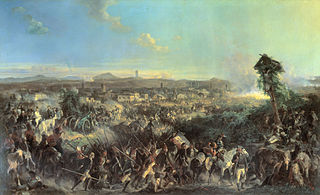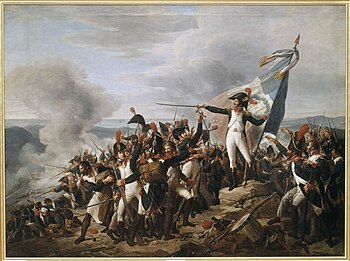
The Battle of Novi saw a combined army of the Habsburg monarchy and Imperial Russians under Field Marshal Alexander Suvorov attack a Republican French army under General Barthélemy Catherine Joubert. As soon as Joubert fell during the battle, Jean Victor Marie Moreau immediately took overall command of the French forces. After a prolonged and bloody struggle, the Austro-Russians broke through the French defenses and drove their enemies into a disorderly retreat, while French division commanders Catherine-Dominique de Pérignon and Emmanuel Grouchy were captured. Novi Ligure is in the province of Piedmont in Northern Italy a distance of 58 kilometres (36 mi) north of Genoa. The battle occurred during the War of the Second Coalition which was part of the French Revolutionary Wars.

The Second Battle of Dego was fought on 14 and 15 April 1796 during the French Revolutionary Wars between French forces and Austro-Sardinian forces. The battle was fought near Dego, a hamlet in northwestern Italy, and ended in a French victory.

The Battle of Montenotte was fought on 12 April 1796, during the French Revolutionary Wars, between the French army under General Napoleon Bonaparte and an Austrian corps under Count Eugène-Guillaume Argenteau. The French won the battle, which was fought near the village of Cairo Montenotte in the Kingdom of Piedmont-Sardinia. The modern town is located in the northwestern part of Italy. On 11 April, Argenteau led 3,700 men in several assaults against a French mountaintop redoubt but failed to take it. By the morning of the 12th, Bonaparte concentrated large forces against Argenteau's now-outnumbered troops. The strongest French push came from the direction of the mountaintop redoubt, but a second force fell on the weak Austrian right flank and overwhelmed it. In its hasty retreat from the field, Argenteau's force lost heavily and was badly disorganized. This attack against the boundary between the Austrian and Sardinian armies threatened to sever the link between the two allies. This action was part of the Montenotte Campaign.
In the Battle of Ceva on 16 April 1796, troops of the First French Republic under Pierre Augereau fought against part of the army of the Kingdom of Sardinia-Piedmont led by General Giuseppe Felice, Count Vital. Augereau assaulted the strong defensive position without success. At the direction of the Sardinian army commander, Feldmarschal-Leutnant Michelangelo Colli, Vital withdrew on the 17th in order to avoid being trapped by a second French division.

Johann Peter de Beaulieu, also Jean Pierre de Beaulieu, was a Walloon military officer. He joined the Habsburg army and fought against the Prussians during the Seven Years' War. A cultured man, he later battled Belgian rebels and earned promotion to general officer. During the French Revolutionary Wars he fought against the First French Republic and attained high command. In 1796, a young Napoleon Bonaparte won some of his first victories against an army led by Beaulieu. He retired and was the Proprietor (Inhaber) of an Austrian infantry regiment until his death.
In the Battle of Fleurus Jean-Baptiste Jourdan's French army repulsed an attack by the combined Austro-Dutch army led by Prince Josias of Saxe-Coburg-Saalfeld. Tactically the battle was a draw but strategically it was a decisive French victory. The battle led to the collapse of the Coalition position in the Austrian Netherlands.
In the Battle of Jemappes on 6 November 1792, a French army led by Charles François Dumouriez attacked and defeated an Austrian army commanded by Albert of Saxe-Teschen. Though the Austrians were outnumbered three-to-one, the victory greatly encouraged the population of the young First French Republic and lead to the evacuation of Austrian forces from the Austrian Netherlands. Note: all units have their names as they are translated in English.
In the Battle of Rivoli on 14 and 15 January 1797, the French Army of Italy led by Napoleon Bonaparte crushed the main Austrian army led by Jozsef Alvinczi. The battle occurred during the fourth Austrian attempt to relieve the Siege of Mantua. After crippling Alvinczi's army on the 14th, Bonaparte left Barthélemy Joubert and Gabriel Rey to finish off the Austrians and raced south with André Masséna to deal with a relief column led by Giovanni di Provera. On 16 January, Masséna, Pierre Augereau, and Jean Sérurier trapped Provera near the Mantua siege lines and forced his surrender.

Michelangelo Alessandro Colli-Marchi or Michelangelo da Vigevano or Michael Colli entered the Habsburg Austrian army as a commissioned officer and became a general officer after fighting in the Seven Years' War, War of the Bavarian Succession, and Austro-Turkish War. During the War of the First Coalition, he was loaned to the Kingdom of Sardinia-Piedmont for three years. In 1796, his army was defeated by Napoleon Bonaparte in a swift campaign that knocked Sardinia-Piedmont out of the war. In early 1797, he was given command of the army of the Papal States, but his troops were defeated at Faenza.

Mathias Rukavina von Boynograd was a Croatian general in the Habsburg monarchy imperial army service. He joined the army in 1755 and fought against the Kingdom of Prussia, Ottoman Turkey, and the First French Republic. For most of his career he served with the light infantry from the military border with Turkey. He earned the rank of general officer during the French Revolutionary Wars, distinguishing himself at Loano. During the 1796 Italian campaign, he commanded a brigade in several battles against the French army led by Napoleon Bonaparte. He was Inhaber (Proprietor) of an Austrian infantry regiment in 1803–1804.

On 25 March 1799, French and Habsburg armies fought for control of the geographically strategic Hegau in present-day Baden-Württemberg. The battle has been called by various names: First Battle of Stockach, the Battle by Stockach, and, in French chronicles, the Battle of Liptingen.

Anton Ferdinand Freiherr Mittrowsky von Mittrowitz und Nemyšl, or Anton Mittrowsky, was promoted to general officer in the spring of 1796, just in time to lead a brigade against Napoleon Bonaparte during the 1796–1797 Italian Campaign in the War of the First Coalition. He served as a regimental commander in 1792–1796, leading his unit at Neerwinden, Famars, and Le Quesnoy in 1793. In the following year, he led the regiment at Landrecies, Beaumont, Courtrai, and Fleurus. In 1796, he led a brigade at Castiglione and 2nd Bassano, and played a pivotal role at Arcole, nearly defeating Bonaparte. In 1799, he commanded troops at Verona, Magnano, Novi, and Genola. During the Napoleonic Wars he led forces at Caldiero in 1805. He became the Proprietor (Inhaber) of an Austrian infantry regiment from 1806 until his death three years later.

In the Battle of Hohenlinden on 3 December 1800, a French army commanded by Jean Victor Marie Moreau decisively defeated the army of Habsburg monarchy led by Archduke John. The first action of the campaign was the Battle of Ampfing, two days earlier. After Hohenlinden there was a series of rearguard clashes beginning on 9 December at Rosenheim and continuing from the 14th through the 20th at Salzburg, Neumarkt am Wallersee, Frankenmarkt, Schwanenstadt, Vöcklabruck, Lambach, and Kremsmünster. During the retreat, the Habsburg army began a process of disintegration and an armistice was concluded a few days later.

The Battle of Ettlingen or Battle of Malsch was fought during the French Revolutionary Wars between the armies of the First French Republic and Habsburg Austria near the town of Malsch, 9 kilometres (6 mi) southwest of Ettlingen. The Austrians under Archduke Charles, Duke of Teschen tried to halt the northward advance of Jean Victor Marie Moreau's French Army of Rhin-et-Moselle along the east bank of the Rhine River. After a tough fight, the Austrian commander found that his left flank was turned. He conceded victory to the French and retreated east toward Stuttgart. Ettlingen is located 10 kilometres (6 mi) south of Karlsruhe.

Caldiero 1805 order of battle

The Battle of Verona was fought on 18 October 1805 between the French Army of Italy under the command of André Masséna and an Austrian army led by Archduke Charles, Duke of Teschen. By the end of the day, Massena seized a bridgehead on the east bank of the Adige River, driving back the defending troops under Josef Philipp Vukassovich. The action took place near the city of Verona in northern Italy during the War of the Third Coalition, part of the Napoleonic Wars.
The Battle of Sacile saw the Franco-Italian Army of Italy commanded by Eugène de Beauharnais face the Archduke John of Austria's Army of Inner Austria during the War of the Fifth Coalition. Believing that he was only opposed by the Austrian VIII Armeekorps, Eugène launched his right wing in a heavy attack against it. In the morning, the Austrians successfully held off Franco-Italian assaults on their left flank as Eugène reinforced the attack with troops from his left wing. Later in the day, John counterattacked Eugène's weakened left wing with the IX Armeekorps, forcing the Franco-Italian army to withdraw from the battlefield. The battle at Sacile was preceded by the action of Pordenone on 15 April in which the Austrian advance guard mauled the French rear guard. The Austrian victory compelled Eugène to retreat to the Adige River at Verona where he gathered reinforcements and planned a counteroffensive.
The Piave River 1809 order of battle shows the units and organization for the Franco-Italian and Austrian Empire armies that fought in the Battle of Piave River on 8 May 1809. Eugène de Beauharnais, the viceroy of the Kingdom of Italy defeated Archduke John of Austria. Eugène's Advance Guard crossed the river first and was assailed by Austrian cavalry and artillery. The French cavalry routed the opposing cavalry and captured 14 enemy guns. A lull followed as John arranged his infantry in a formidable defensive position. Meanwhile, Eugène struggled to pour reinforcements into the bridgehead as the Piave rose dangerously. In the afternoon, the viceroy sent Paul Grenier to drive back the Austrian left while Jacques MacDonald mounted an assault on the center. The attack succeeded in breaking the Austrian line and compelling John to order a retreat.
The Battle of Voltri was an engagement occurring on 10 April 1796 during the French Revolutionary Wars and taking place in Voltri, a suburb of Genoa, Italy.
Philipp Pittoni Freiherr von Dannenfeld, fought in the army of Habsburg Austria during the French Revolutionary Wars. Promoted to general officer in 1795, he was a brigade commander in northwestern Italy at the time when Napoleon Bonaparte was appointed to lead the opposing French Army of Italy. He led one of the two main columns at Voltri in April 1796. At Borghetto in May, he unsuccessfully defended the bridge. He led a brigade at Castiglione in August and at Second Bassano and Arcole in November 1796. He retired from service the following year and died at Gorizia in 1824.












